Last soldier to fire on advancing Nazi troops during WWII Battle of Knightsbridge dies aged 94
-
•Ray Ellis, who died in Nottingham, was last surviving veteran of 1942 battle
-
•Saw 107th Regiment of South Nottinghamshire Hussars virtually wiped out
-
•He was captured and taken to POW camp, but launched successful escape
-
•Battle in Libya was ironically named because it was barren desert crossing
By Mark Duell
PUBLISHED: 18:25, 23 February 2014 | UPDATED: 02:03, 24 February 2014
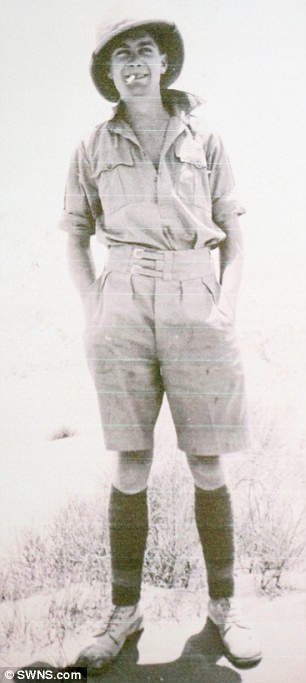
Hero: Ray Ellis was the last surviving veteran of the 'Battle of Knightsbridge' - one of the most celebrated acts of bravery in the Royal Artillery's history
The last soldier to fire on advancing German troops in one of the Second World War’s most important battles has died aged 94.
Ray Ellis, who died in Nottingham, was also the last surviving veteran of the famous 'Battle of Knightsbridge' in 1942.
The battle - one of the most celebrated acts of bravery in the Royal Artillery’s history - saw the 107th Regiment of the South Nottinghamshire Hussars virtually wiped out.
Former Hussar Captain Gil Aldridge hailed Mr Ellis as the last soldier to fire on the Germans at the end of the battle. Ordered to 'fight to the last man and the last round', they stuck to their guns as their comrades fell around them.
For three days, the band of Desert Rats suffered relentless Panzer attacks and mounting casualties as they held the line in North Africa from German Field Marshal Erwin 'Desert Fox' Rommel's advancing tanks. Their heroism during one of the bloodiest battles of the Second World War was later immortalised on canvas.
Mr Ellis was captured and taken to a prisoner of war camp, but launched a daring escape and found shelter with a sympathetic family.
He was shipped from Libya to the camp in Italy but escaped by marching out of the main gate as if on a work party and hid in the mountains for a year. A young girl discovered him and led him to the farming family who sheltered him.
Mr Ellis named one of his daughters, Nerina, after her, and has returned regularly to the hill village of Massa Fermana, near Ancona, to visit the family who kept him alive.
Describing the events of the last day of the battle on June 6, 1942, Mr Ellis told how he remained at his 25-pounder gun and witnessed the death of the shirtless comrade beside him.
He said: ‘My regiment had been given the order to fight to the last man and the last round and not to retire, and this painting shows our position after a long day's battle. I fought in that battle.
‘The regiment was almost wiped out - but by some miracle, I was the last man virtually, and I fired the last round. That round, which was at about six o'clock at night, hit a Mark IV tank.
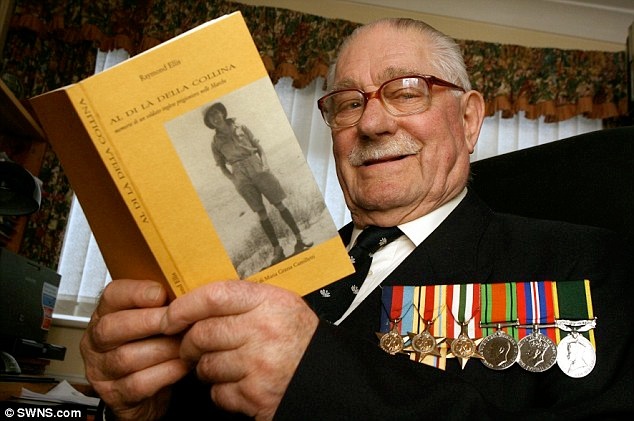
Dead at 92: Mr Ellis wrote a book about his experiences in the Battle of Gazala in 1942, called Once a Hussar, which was published last year. He is pictured with the Italian version of the book
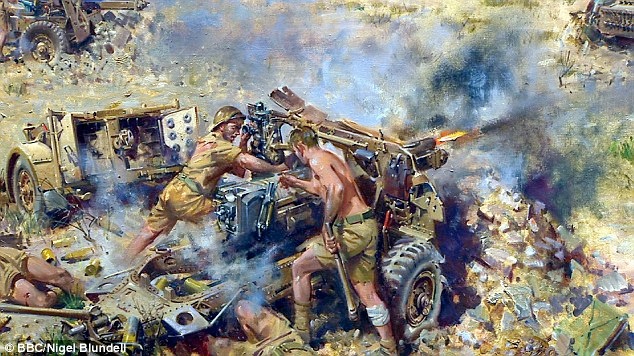
Battle of Knightsbridge: For three days in 1942, the men suffered relentless Panzer attacks and mounting casualties. Their heroism was later immortalised on canvas in this 1978 war painting by Terence Cuneo
'Then the man standing at the side of me was killed because a German tank had come up behind us and fired its machine gun, almost point blank. And I took a deep breath and waited for mine.
'For some reason the tank didn't fire and I survived and am still here. You feel guilty for having survived. I found my comrade Jim Hardy lying nearby. He had been cut in two.
'I took his water bottle and drank his water. I was in tears when I was taken prisoner.'
Mr Ellis was among 90 men from his regiment who were captured at the Battle of Knightsbridge, ironically named - possibly by a homesick soldier - because it was a barren desert crossing.
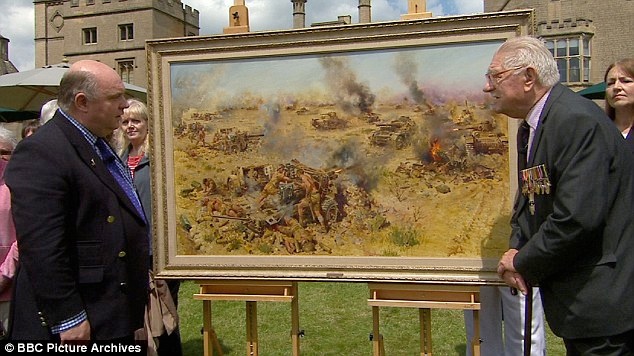
TV appearance: Mr Ellis (right) on the Antiques Roadshow with the painting and firearms expert Bill Harriman
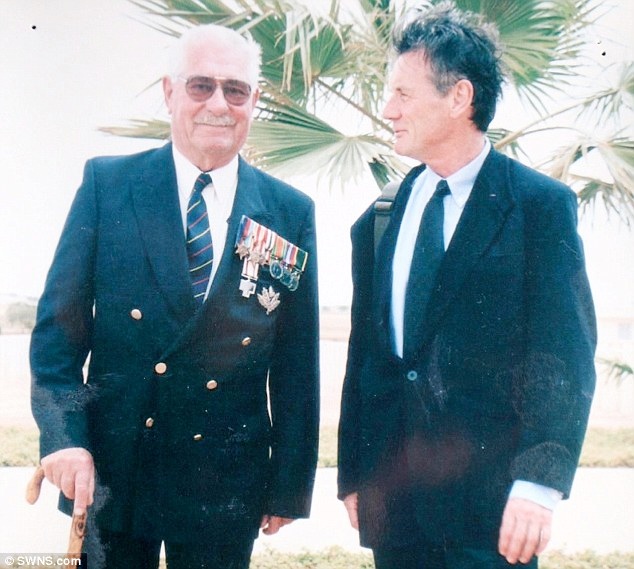
Decorated: Ray Ellis was captured and taken to a prisoner of war camp during the Second World War, but launched a daring escape and found shelter with a sympathetic family. He is pictured with actor Michael Palin
IRONICALLY-NAMED BATTLE SCENE
The location of the Battle of Knightsbridge, which took place in 1942, was ironically named because it was a barren desert crossing.
The three-day fight formed part of the Battle of Gazala - fought from May 26 to June 20, 1942 - which was seen as German Field Marshal Erwin Rommel’s (above) greatest triumph.
The British army suffered relentless Panzer attacks and mounting casualties as they held the line in North Africa from Rommel’s advancing tanks. They had been ordered to delay the Germans at ‘Knightsbridge’ to protect the 8th Army as it withdrew.
The climax of the attack came at Knightsbridge, near Bir Hacheim in Libya, as Rommel hit back upon every British counter-attack and destroyed the British forces.
Some 90 men from 107th Regiment of the South Notts Hussars (badge above) were captured - including Mr Ellis - while the rest of the regiment were killed.
The rest of the regiment, which had already served in the nine-month Siege of Tobruk the year before, were killed.
Captain Aldridge said yesterday: ‘I believe he was going to marry a girl who was part of that Italian family but it didn't happen, although I understand he went back and visited them every year.
‘He was a man who definitely had his wits about him but he was a gentleman, and that is what everyone said about him.’
Mr Ellis wrote a book about his experiences in the Battle of Gazala in 1942, called Once a Hussar, which was published last year.
He was also invited to the Royal Military Academy at Sandhurst to talk to recruits about his experiences.
His bravery was praised by Lieutenant Colonel David Young, president of the South Notts Hussars' Association, whose uncle, Col Billy Seely, was commanding officer and died at the Battle of Knightsbridge.
He said: ‘Ray Ellis was a true and proud South Notts Hussar.
‘His exploits during the last war, from his joining the regiment in 1939, his survival at Knightsbridge, his imprisonment and ultimate escape from a PoW camp in Italy, so valuably recorded in his book Once a Hussar, have become a valuable archive as to what happened to a volunteer soldier.
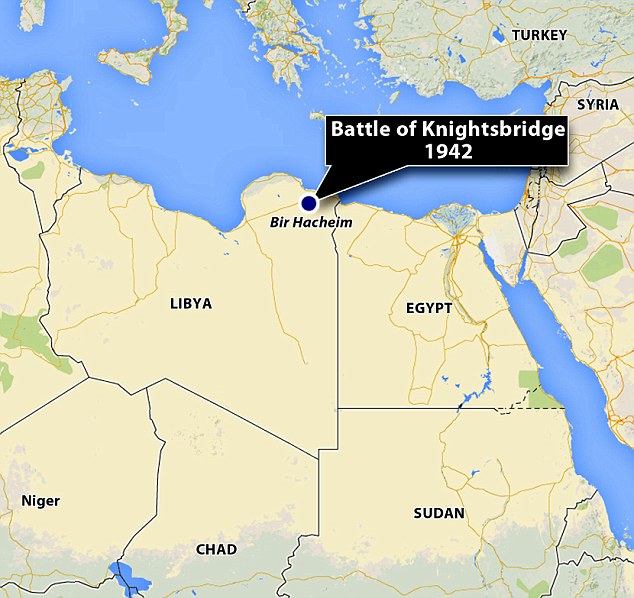
Location: The climax of the attack came at Knightsbridge - ironically named because it was a barren desert crossing - near Bir Hacheim in Libya, as Rommel hit back upon every British counter-attack
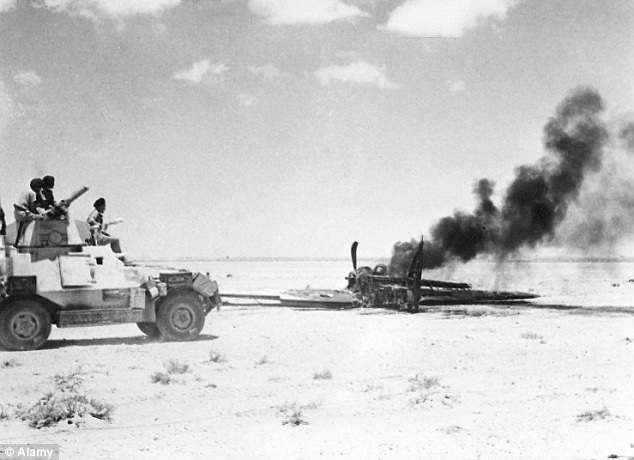
Smoking: An armoured car crew watch a German plane downed by British in North Africa on June 8, 1942, during the Gazala campaign - which the Battle of Knightsbridge was part of. The pilot died in the blazing cockpit
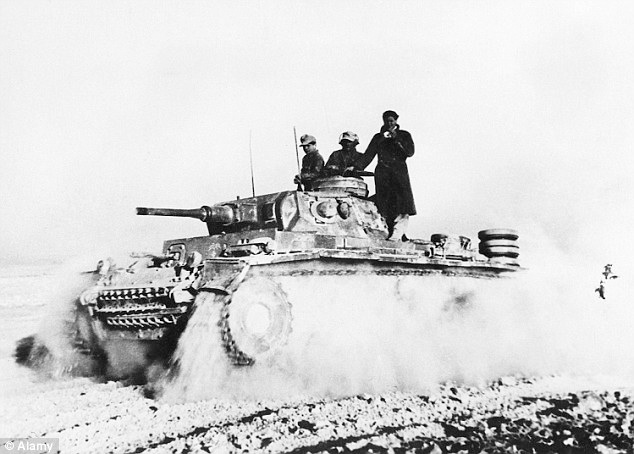
Bloody battle: A German Panzer III Ausf. A, F model, tank and troops advancing during fighting in North Africa in June 1942, during the Gazala campaign
‘Members of the South Notts Hussars continue to be mesmerised by his personal account of the Battle of Knightsbridge - a story so vivid and so emotional one felt one was there standing beside him when he fired that last round.
'You feel guilty for having survived. I found my comrade lying nearby. He had been cut in two'
Ray Ellis
‘His recent lectures at Sandhurst are an acknowledgement of the respect and high regard with which he was held within the Army as well as being an inspiration to both students and instructing staff alike.’
Mr Ellis, a former sergeant, died last Tuesday at the Queen's Medical Centre in Nottingham.
Col Tim Richmond, Honorary Colonel of the South Notts Hussars, said: ‘We regarded Ray and all those who fought as a band of brothers at Tobruk and Knightsbridge as heroes and the sacrifices that they made will never be forgotten.’